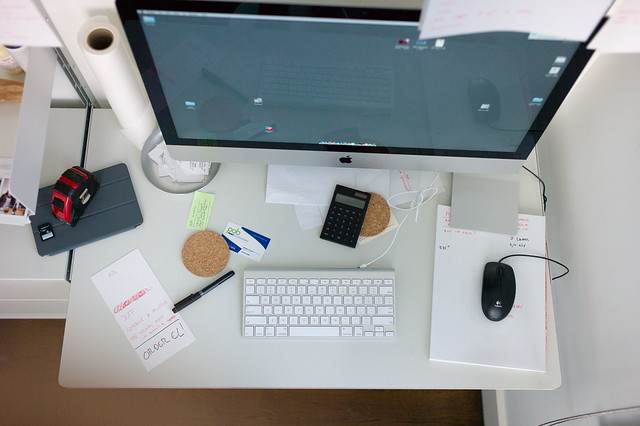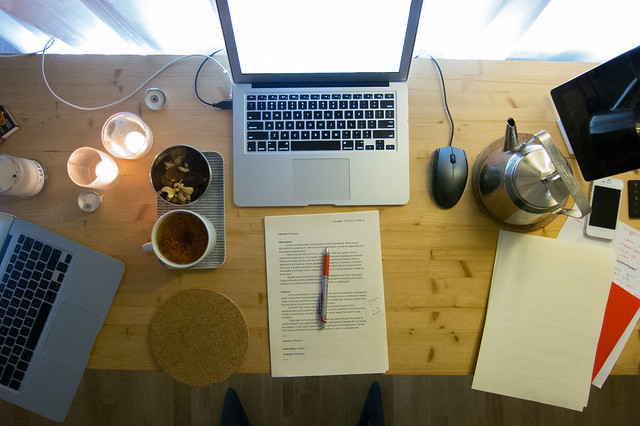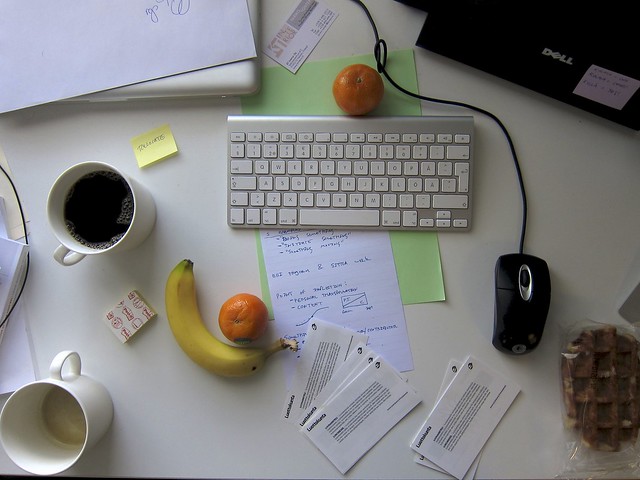
Bryan Boyer's workspace, October 2013, from his Flickr set, How We Work (All rights reserved by bryanboyer)
Rena Tom and Bryan Boyer have been thinking about how freelancers work, personally and professionally, for much of their careers. Rena owned and operated the cult design store and gallery Rare Device, and has also worked as a designer of jewelry, stationery and web pages. Bryan, trained as an architect, was most recently Strategic Design Lead at Sitra, the Finnish Innovation Fund. Among his projects there was Brickstarter, about which I wrote here. But rather than industrial design machines like cubicles, cases or office landscapes, they've created an idiosyncratic place to which freelancers can bring their laptops, headphones, and caffienated beverages. A space in which, they hope to create a sense of community and strenth in numbers.
In September 2012, Tom opened Makeshift Society in San Francisco. The society is,
an organization that fosters creativity, collaboration and community through a coworking space/clubhouse, innovative programming, and support for freelancers and small business owners. We want to enable everyone to make, learn, teach, and think.Now they are bringing that model to Brooklyn, in a larger space in Williamsburg. They have the money to build it out, but they are currently running a Kickstarter campaign to create a creative tool lending library for that space. New York apartments make it hard to store, and use, the books, materials and equipment one needs once and a while.
In the Q&A below, Rena and Bryan talk about their lessons learned about workspace, community, and how to develop a business out of your own needs. (Answers without initials were co-written by both of them.) If you like what you hear, if you are thinking about becoming a member, please give to their Kickstarter. It ends October 31.
What are your own workspaces like?
Rena Tom: I work at Makeshift, choosing a new seat every day like everyone else. Whatever is in my backpack comes tumbling out (pen and paperwork, headphones for Skype calls, Mojo bars) and at the end of the day, I pack up again. After my son goes to sleep, I sit in bed and continue on my laptop.
Bryan Boyer: Workspaces is an accurate term. I work between a compact desk at home, the kitchen table where I can spread out papers or a stack of books, the fold down tray of an airplane, and a large shared desk at Dash Marshall. Everything’s on Dropbox and in my sketchbook, so if I have my laptop, a pen, a mouse (the trackpad is no good for drawing), and headphones I can be productive.
When you came up with the original Makeshift idea, Rena, was it based on your own preferences? Research?
RT: My ideas always start with what I feel like I need, and then when the chorus of “me too!” happens with my friends, I know I’m on to something. At that point, I let go of the original idea so it can become relevant to more people. Makeshift was at first just going to be a lending library for design books, and I’d split the rent with a couple friends Victoria Smith (sfgirlbybay blogger) and Suzanne Shade (creative director/muse at Minted) and eventually it turned into what it is today.

Rena Tom's workspace, October 2013 (photo by Rena Tom)
How is Makeshift different from other co-working spaces?
As a community two aspects make us unique. The first is that we’re focused on creative entrepreneurs; those who are paying their bills by pursuing their creative passion, whether that is architecture, jewelry making, photography, writing, or something else. Our focus is on getting people to the point where those hobbies or side projects can be a source of financial independence. We also have more female members at Makeshift than most other coworking spaces. As one of our (male) members put it, “at Makeshift it’s not like you’re surrounded by a bunch of sweaty guys.”
As a place, we focus on having a diversity of micro-environments that suit our members at different times and in different moods. Even though SF is not quite 1000 square feet we have bright corners and darker ones, work desks and softer spots like sofas, seats for up to 20 and even a nap loft if someone needs down time. Despite making claims of freeing their members from the corporate grind, a number of the coworking spaces we saw when doing research for Makeshift look rather like a nicely appointed corporate office.
At the most basic level, what have you discovered people need: how much space, what kinds of supplies, what kinds of amenities?
There are metrics out there for traditional office space, and Cooper Union recently did a nice survey of studios, but we used these as a starting point more than a rule. Our drop-in model in SF means that people often sit quite close together compared to what one would expect them to be doing based on the recommendations. And of course at other moments people are taking far more space than they “should”. The most basic need is flexibility.
Fast internet, WiFi, and copious power outlets are the starting point. A printer helps. We’ve thought about adding a fax machine in NYC because it’s the sort of thing that you use very seldomly, but when you do it’s often the only option and finding one can be so annoying.
The qualities of the space are the more important amenities, really. Things like an easily-accessible location; a nice, calm, well-designed environment; great daylight. These relate to aspects of the community as well: being able to leave your things around while you step out for a bit saves a lot of the hassle that one endures when working as a constant guest. Being surrounded by people who are working as hard as you are helps create a contagious sense of motivation. And being in a place where your peers are working on interesting things is critical.
Why did you decide on a membership model? How is that responsive to the way people work now?
Makeshift’s membership plans are a recognition that work is defined by activity, not by place. For many of our members, Makeshift cannot make a legitimate claim to being the only place where their work happens. Perhaps they spend three days a week with us, work from home once a week, and spend another day around the city in meetings or at a client’s office. One of our photographers, for instance, comes to Makeshift when she wants to do administrative tasks because she can meet new people and then focus when she needs to, but other parts of the week she works from home or out on shoots.

Bryan Boyer's workspace, October 2012, from his Flickr set, How We Work (All rights reserved by bryanboyer)
As you think about opening the Brooklyn space, what are you designing differently?
RT: I have a feeling that Brooklyn members will more results-oriented than the San Francisco crew, or at least they are in a greater hurry to get there! We’ll accommodate that with tighter programming (events and classes), but we also want to import some of the West coast vibe, which has a somewhat longer-term and broader definition of “results”, along with acting in a mutually beneficial manner. (Adam Grant’s book Give and Take has quite a bit more to say about that.) We want to show that flipping roles and being a teacher sometimes and a student other times is extremely valuable.
One of the ways that this will be expressed architecturally is a very slight emphasis on the more traditional studio model. In SF we do not have dedicated desks, but in NYC we will. In SF we have one small conference room, in NYC we’ll have one small room for focused discussion as well as one larger room for presentations, and a number of phone booths.
BB: I also want to mention something that’s not going to change in BK. We’re making a commitment in this location to having an open workspace, so you will not see any miniature glass cubicles. We’re going to keep BK as open as possible, just like SF.
Bryan, you said at a Makeshift event earlier this year that you were hoping to get more architects involved with the Brooklyn space.
BB: I watch many of my colleagues struggle with the practicalities of starting and operating small architecture offices, so I have a strong desire to help people find their way more easily. I’m inspired by the spirit of collaboration that’s central to the technology world (which I used to play a more active role in).
It would be great to have a couple of small architecture offices working out of Makeshift because they have so much to gain from sharing a space with people who know how to do marketing, who can help with graphic design, who can build websites, who can write in an accessible way ... you get my point.
How do you see your spaces as interacting with the cities and neighborhoods around them?
We’re deliberately choosing neighborhoods that are lively, with bubbling street life and a significant number of local residents. Makeshift Society works best on the ground floor where big windows encourage passers-by to enter, and where the view of the street provides visual stimulation for our members.
Most of the SV companies you’ve written about start from the premise that they need to protect their secrets and capture 100% of their workers’ intellectual capital, which has the effect of turning them inwards as closed campuses where every idea has a whiteboard to land on, and every door secured by a keycard. The city itself is humanity’s best engine for connections and inspiration, but again and again we see corporations recreate a sanitized, interior version of a city all for themselves. The city-within-a-city architectural strategy becomes irrelevant or even counter-productive if you’re not constrained by the same IP concerns.
Makeshift has the freedom to embed ourselves in the existing networks of the city itself, and to benefit from the actual, spectacular diversity that’s already there. We don’t need to have our own privatized transportation system, we need to be located near public transit like the subway and citibike; we don’t need to go through the gymnastics of creating ‘interior streets’ or plazas. We have a real street right outside our windows!

Bryan Boyer's workspace, March 2011, from his Flickr set, How We Work (All rights reserved by bryanboyer)
How do the members get there?
RT: In San Francisco, most members live close by, but we do have some who come from other counties, as well as people who work on a day pass when they’re in from out of town. We haven’t done a survey but I’m going to guess that 15-20% drive, and the rest use public transit, walk or ride a bike.<
BB: In NYC we’re expecting even more to use public transit, including Citibike which is one block away.
There's a lot of discussion of coworking in general now, based on the rise of the freelance economy. As that economy becomes established, are there more spaces, places, amenities you think freelancers will need?
Those new to freelancing are often surprised by how much infrastructure (and money) is involved. While we see portraits of work-anywhere laptop warriors in the news, hardware is just one part of the toolkit you need to survive, and possibly the least expensive. Organizations like Freelancers Union are using the power of the group to provide insurance but also visibility and a voice for hard-working people whose lifestyle is sometimes discounted.
The most important effect of the proliferation of coworking spaces is a rather simple one: it means that another financial hurdle that used to block people from striking out on their own is being lowered. This is part of a larger change that’s happening in the economy as things shift from a pay-for-ownership model to a pay-for-access model.
While costs are dropping, it’s still hard to find business and good collaborators, so these are the things that we think about as big questions for the future of the freelance economy.
For the moment we at Makeshift still believe in the primacy of face to face interaction as the way to build the trust that’s fundamental to longstanding, successful collaboration. We could have set it up as a bunch of friends sharing a workspace, but that would have limited the community to people who are already in our social network. The last thing we want to do is feel like we’ve finally escaped from the ‘old boys network’ to find ourselves in a ‘new boys network’!
Since I'm taking a future-of-libraries class: What about the library?
BB: Maybe a library is where you go for intense focus. In fact, that’s why why we’re not aiming for a ‘library quiet’ environment. It’s got “library” in the name. We can do other things better.
RT: Libraries functionally are like coffee shops, for freelancers, with similar turn-offs: no guaranteed seating, no guaranteed power outlet or fast WiFi, and the need to pack up your bag if you want to grab lunch or use the restroom. Also, there’s an unspoken rule that you don’t interact with people at the library - they are classically quiet zones. Even more than a workspace, our members are craving connection with others.
Related: I (Alexandra) have also been thinking about how we freelancers work as part of my class with Harvard's metaLAB, Library Test Kitchen. Students in the class are tasked with designing a library machine. My machine has become a portable place of work, the Bureau-to-Go, that dedigitizes the desktop and removes the friction of unpacking, faulty WiFi, limited natural light. Most of us need more than a laptop to work well, and it was interesting to think through which objects, in what arrangement, I would take on the road. Because I took the assignment too personally, I forgot the headphones at the top of everyone else's list (I don't listen to music). But they are first on my list for the next prototype.
